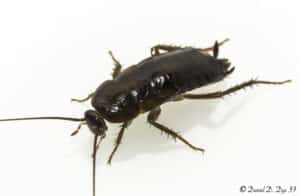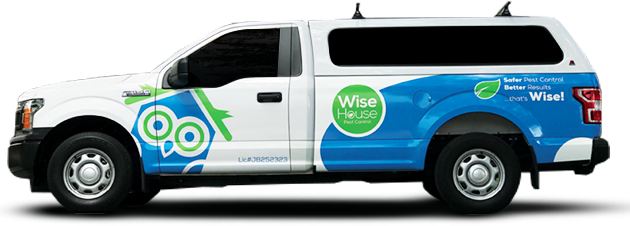Ever seen a big, dark roach in your bathroom or laundry room? If it left a stinky smell, you probably just encountered an oriental cockroach. In South Florida, these cockroaches are often referred to as “water bugs.” They might not be as common as palmetto bugs, but you definitely don’t want them in your house.
In this blog, you’ll learn how to spot them, keep them out of your home, and get rid of them if they’ve already moved in. We’ll cover everything from simple cleaning tips as well as other solutions.
Whether you’re dealing with a minor incursion or a full-blown infestation in your South Florida home, we provide some viable solutions to effectively get rid of oriental cockroaches in your home.

The Oriental cockroach, scientifically known as Blatta orientalis, is a prevalent pest in South Florida, often referred to as “water bugs” due to their affinity for damp environments.
These dark brown to black insects, measuring about 1 to 1.25 inches in length, are known for their glossy appearance and foul odor. Oriental cockroaches are particularly well-suited to South Florida’s humid climate, thriving in warm, moist areas both inside homes and outdoors.
Indoors, they’re typically found in damp areas like crawl spaces, and near leaky pipes. Outside, they can be found in sewers, drains, mulch piles, or under piles of leaves. These roaches aren’t picky eaters, consuming decaying matter, garbage, and even feces, which makes them potential carriers of various diseases.
Although they don’t usually bite or attack humans, Oriental cockroaches are a major nuisance due to their nasty habits. They can contaminate food and surfaces with bacteria and allergens, potentially triggering allergies or asthma in some people.
Because they reproduce quickly and are resistant to certain pesticides, getting rid of them can be a real challenge and often requires the help of a professional pest control company.
The Oriental cockroach has a distinctive appearance that sets it apart from other roaches commonly found in South Florida. Adults typically measure between 1 to 1.25 inches in length, with females being slightly larger than males. They have a glossy, dark brown or black exoskeleton, giving them a shiny appearance.
Their bodies are oval-shaped and flattened, allowing them to easily squeeze into tight spaces. While both males and females have wings, neither can fly, with the males having shorter wings that cover about three-quarters of their abdomen and the females having very short, underdeveloped wings.
Identifying Oriental cockroaches can be done by looking for their unique characteristics and habitats. They are often found in damp, cool areas such as crawl spaces, garages and around plumbing fixtures.
You might also find them outdoors in sewers, drains, mulch beds, or under leaf litter. If you notice a large, dark-colored roach with a shiny body and a tendency to gravitate towards damp areas, it’s likely an Oriental cockroach.
Be wary of their presence, as they are known for emitting a musty odor and can contaminate food and surfaces with bacteria. If you suspect an infestation, taking appropriate action quickly is important to prevent them from increasing their population.
Oriental cockroaches exhibit fascinating behaviors and a complex life cycle. Unlike their more agile cousins, these roaches are relatively slow-moving, preferring to scuttle along surfaces rather than fly, despite having wings. They are primarily nocturnal creatures, emerging from their hiding places under the cover of darkness to forage for food.
These scavengers have a diverse palate, consuming a wide range of decaying organic matter, garbage, and even feces, which unfortunately allows them to carry harmful bacteria. Interestingly, while most cockroaches prefer warm temperatures, Oriental cockroaches are more tolerant of cooler environments, typically favoring temperatures between 70-80°F (21-27°C). This unique preference often drives them to seek refuge in garages, crawl spaces, and damp areas near plumbing leaks within homes.
The life cycle of an Oriental cockroach involves three distinct stages: egg, nymph, and adult. A female cockroach produces an egg capsule, or ootheca, which can contain up to 16 eggs. She carries this egg case for a period of time before depositing it in a warm, sheltered location with a readily available food source. The incubation period for these eggs can vary depending on temperature, but it typically takes around 42-81 days for the nymphs to hatch.
The nymphs, which resemble miniature adults but lack wings, undergo a series of molts as they grow. It takes about a year for them to reach adulthood, shedding their exoskeletons multiple times in the process. Adult Oriental cockroaches can live for several months, during which they mate and continue the cycle.
Notably, unlike other cockroach species, Oriental cockroaches tend to have a seasonal developmental cycle, with peak populations occurring in late spring or early summer. Understanding these intricate details of their behavior and biology is essential for effective pest management and control strategies.
Controlling oriental cockroach infestations in your South Florida home requires an approach that combines sanitation, exclusion, and targeted treatments:
While Oriental cockroaches do not bite or sting, they can be harmful because they are known to carry and spread bacteria, viruses, and other pathogens, potentially causing food contamination and illness.
Oriental cockroaches are attracted to moisture and decaying organic matter. They are commonly found in garages, crawl spaces, under sinks, in sewers, and other damp areas. Leaky pipes, standing water, and food debris can attract them to homes.
These cockroaches can enter homes through gaps and cracks in foundations, doors, and windows. They may also come in through sewer pipes, drains, and other plumbing fixtures.
Oriental cockroaches have wings, but they are not strong fliers. They primarily move by crawling.
No, even clean homes can become infested if there are suitable conditions such as moisture and access points. However, maintaining cleanliness can reduce the likelihood of an infestation.
Yes, Oriental cockroaches are nocturnal and are most active at night when they search for food and water. Seeing them during the day may indicate a large infestation.
Yes, their droppings, shed skins, and saliva can trigger allergies and asthma symptoms in sensitive individuals. This makes it important to address infestations promptly.

Ready to send away pests without harming your pets? Getting started with Wise House Environmental Services is as easy as 1-2-3:
With Wise House Environmental Services, you get more than just effective pest control; you get peace of mind, knowing that your home is without pests and safer for your pets.
Our approach to pest control combines science with safety, offering you the kind of targeted, effective solutions that you won’t find with just any other pest control service. Our services have made a world of difference for homeowners, and we can do the same for you. Your pets will thank you for it!
We serve Port St. Lucie,Lake Worth, Boyton Beach, Palm Beachand the Treasure Coast.


© 2023 All Rights Reserved. | Sitemap